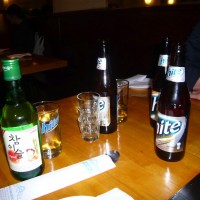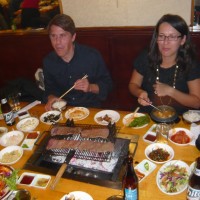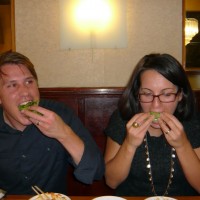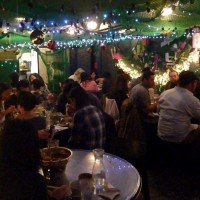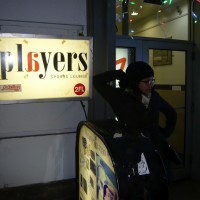I’m not a kimchi virgin. I’ve grown to love NYC’s Koreatown over the past few years. But that doesn’t mean I have much of a clue as to where to go and what to order without the advice of internet foodies who have gone before me. So when my Korean friend invited Brad and I to join him for some Koreatown BBQ, I of course said yes.
I sat back and let him order for the table (in Korean of course), drank the soju he poured, and when he stuffed a lettuce roll full of bulgogi into his mouth like a chipmunk hoarding a nut, I tried my best to do the same. When all signs pointed to party, we eventually followed him to some seedy yet somehow swanky joints on the upper floors of the buildings that line one of the most amazing blocks in midtown Manhattan.
Thanks to my long time friend, Paul Kim (who served as our guide and photographer for an evening), I present to you a guest post on how to chow like a Korean in Koreatown.

Things to keep in mind before going out for a night to Koreatown, NYC or to your local Korean restaurant establishment:
- Do not plan on taking a significant other whom you just started dating. The way to really enjoy Korean food is to be glutenous and ravenous. This means a lot of overstuffing your face and quiet long silences due to large amounts of food in your mouth. Not to say that you can’t follow the standards put forth by Emily Post at a Korean restaurant, but I suggest that if you really want to enjoy the complexities of flavors in your mouth that you check that bitch, Emily Post, at the door.
- Be ready to smell like smoky delicious garlic and meat throughout your clothes and hair. The newest Korean restaurants have very effective vents that suck most of the smoke from the table top grills to eliminate this lingering aroma of food, but depending on which restaurant you decide to dine at, be prepared.
- If you or people in your party are vegetarians I may suggest different alternatives. Korean cuisine has a lot of vegetarian options, but no one goes out for Korean food because they’re vegetarians. If you are vegetarian, know that you will see a lot of raw bloody meat at the table. And all the vegetables dishes will have fish oil in them.
- Don’t chat up the server. These Korean restaurants are really “burn and turn”. You chatting them up to impress them with your knowledge of Old Boy or using the minimal Korean that you learned from your SAT Math tutor is only going to aggravate them. But feel free to raise your hand and even call out to the server to get their attention. This isn’t considered rude, but always use discretion.
Koreatown, NYC evolved on 32nd St and Broadway due to the surrounding neighborhood industries; unlike that of Chinatown or Little Italy where the neighborhoods grew as dual ethnic residential and commercial enclaves. Midtown Manhattan, or more specifically the Garment District, brought in a large influx of Korean immigrants during the late 1970’s and throughout the 1980’s due to the textile industry boom in South Korea during that time. Naturally, these SoKos needed to eat, hence the start of Koreatown on 32nd Street aka Korea Way. It has now grown in size and scope as a destination spot for diners, revelers, and “afterhours” drinkers from multiple ethnicities (ie Koreans and their non-Korean friends) and ages (the younger the better).
I recommended to Heather and Brad that we go to Won-Jo. The place is one of my personal favorites and I’ve been going there for years, but thanks to the likes of David Chang the place had a line out the door overrun by “foodies”. Instead of trying to wait out the line, I recommended that we go to Soot Bul across the street. I didn’t have much experience with this place but, established in 1979, it’s one of the first Korean restaurants in New York City. My parents even dined here back in their younger days. The reason I recommend Won-Jo and Soot Bul over other Korean BBQ restaurants is for one simple reason – hot coals. Won-Jo uses ambered stone coals while Soot Bul uses actual wood coals, which makes a significant difference in my book.
The first thing we did was order Korean beer and soju, a distilled alcohol typically made from rice. If the restaurant you go to offers Hite, I would recommend that over OB. Hite is much lighter and crisper beer than OB, which is more to my liking. As for soju, they’re all pretty much the same. A bottle typically costs about $3 in Korea and is the stand-by drink for most of Korea’s homeless people and businessmen alike. Just something to think about when ordering a $20 12oz bottle at a Korean restaurant in America.
In most Korean restaurants, the moment you sit down the server comes with a large array of small side plates of pickled vegetables called bon chan. The napa cabbage kimchi is the hallmark Korean dish, but try the multiple varieties of kimchi. The kimchi turnips are my personal favorite. We ordered Ddeokbokki with Jap Chae, a stir fried vermicelli noodle dish, as an appetizer. This is an excellent dish with spicy garlic, soy sauce, and sesame flavors, but due to the slippery texture it may be a little difficult for people who are not that skilled with chopsticks. Forks aren’t much help either.
The main event was of course the meat. We ordered the kalbi (short ribs), bulgogi (sliced prime ribeye), and samkyupsal (pork belly). The kalbi and bulgogi are seasoned and marinated, while the samkyupsal doesn’t require much of anything. Once the meat is cooked, you’ll have a plethora of ways to enjoy it. Try as little to as many combinations as you care for, you really can’t go wrong. The best way is to get a piece of lettuce and… Well, I’ll just let this YouTube video explain it. As you can see, you’ve really got to stuff your face. Sometimes I like to tuck one end of the wrap into my cheek and then shove the rest into my mouth like a chipmunk. As I mentioned before – not a good first date idea.
This is where the soju really shines. The way vodka and caviar go together, soju and Korean BBQ go together. Try taking a sip of soju after each mouthfull of a lettuce wrap and enjoy both the cleansing and flavor properties of the alcohol. By the end of dinner you’ll feel extremely satisfied and buzzed enough to want to continue the night and go on to the sometimes posh, sometimes seedy bars in Koreatown. If you’re lucky, you’ll find a bar/lounge that is both seedy and posh at the same time.
 Paul Kim wears glasses, like to to snowboard, and tends to get really loud when he’s excited. He studied photojournalism back when we were college pals, and once upon a time co-founded a streetwear label called Future Relic.
Paul Kim wears glasses, like to to snowboard, and tends to get really loud when he’s excited. He studied photojournalism back when we were college pals, and once upon a time co-founded a streetwear label called Future Relic.



